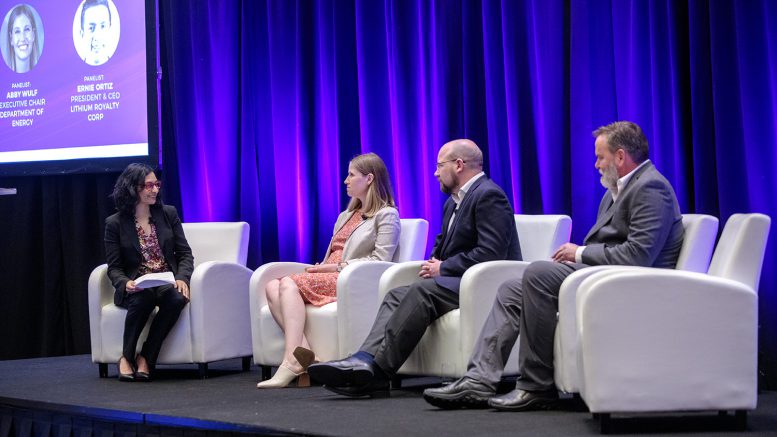Shifting battery metals chemistries present a real challenge for all players in the battery ecosystem, from mineral producers to investors to end-stage users such as automobile manufacturers, panellists said at the Energy Transition Metals Summit in Washington, D.C.
One of the reasons why so many of the players in battery metals ecosystems are struggling is because it remains unclear which battery metals will remain a critical component of batteries and which will fall by the wayside.
The United States is working closely with industry experts to determine “not just where the puck is, but where the puck is going,” Abby Wulf, Executive Chair of the American Batteries Initiative at the Department of Energy, said in an April 30 session at the summit, organized by The Northern Miner and Precious Metals Summit Conferences.
The U.S. is taking a “commodity by commodity approach” when making investments, she said, adding that the government coupled a “short term view and a long, long-term view” to manage the uncertainty in battery composition.
There will always be a mismatch between what miners produce and what end-users require, Andy Leyland, managing director of EV battery consultancy Supply Chain Insights, said.
“Typically [automotive manufacturers] are making decisions on what vehicles they’re going to produce, and what batteries and what chemistries will go in there on a three- to four-year timeframe,” he said. “That’s not enough to bring out a full supply chain.”
Adding to the complexity is how quickly certain markets, such as electric vehicles, are evolving, Frik Els, head of news at strategic metals and minerals advisory Adamas Intelligence, added.
“It’s barely four years ago that Tesla said they are moving from lithium to phosphate. A month later in 2020, [Chinese electric carmaker] BYD came in with the Blade battery.”
BYD’s Blade is a lithium iron phosphate (LFP) battery — a much cheaper, but less powerful chemistry that dominates Chinese production.
End users of batteries will need to be prepared to adjust to supply chain shifts, as it’s difficult to predict which metals will dominate the battery market more than five years out.
This uncertainty is directly impacting investment in mineral production, with generalist investors unwilling to take on the risks inherent in the market.
Ernie Ortiz, president and CEO of Lithium Royalty Corp. (TSX: LIRC), said most investors don’t understand the way the market works.
“The generalist investor assumes that because the price is down 80%, that then that implies that demand was also down a significant growth rate, which is not the case,” he said. Investors need to be educated about the risks, but that’s to be expected for such a young industry still prone to “boom and bust” cycles, he added.
Mainstay minerals
While battery makeup is constantly changing due to research advances, there are metals that the panel agreed would be in demand for the long haul.
Lithium is one such commodity, Leyland said.
“Lithium doesn’t face a huge number of substitution challenges,” he said. However, high price spikes in one commodity generally leads to battery metals researchers developing batteries that rely less on expensive commodities.
“We had a price hike in cobalt in 2018, and then, for numerous reasons, saw cobalt being largely engineered out of batteries,” he said. A similar process happened with nickel following a price increase for that commodity.
However, lithium will remain a mainstay of battery composition because its closest competitor, sodium ion, is slightly weaker on certain metrics, such as energy density.
Lithium is the lightest medal on the periodic table, which lends itself to electric vehicles, Ortiz said. “Lithium-ion battery technology continues to improve and continues to get more affordable over time, and get better energy density, better range, and lower costs.”
“If we don’t get the investment in lithium – which I think we will – we’re going to see sodium ion coming and taking some of that market away, but typically lithium ion will be the winning technology.”
There will be challenges for nickel-manganese-cobalt batteries as these commodities are harder to source.
“We’re finding it incredibly difficult to get the nickel and cobalt projects up and running,” Wulf said. Developing these projects in a timely way to meet ever-shifting demand remains a challenge. “If you need to bring a new cobalt mine online, is it going to be online on time, and if not are you going to still need it?”
The unclear future for battery metals is having an impact on end users and their willingness to invest in raw materials, Leyland said.
“Automotive companies do not want to be mining companies,” Leyland said. “That is a problem.”
Some are beginning to opt for buying Chinese cells just to sidestep investing to develop their own supply chains. Likewise, investors do not want to be subject to large impairment charges due to a collapse in lithium prices, he said.
“They’re in a position where they need to encourage supply,” he said. “They do that by taking a long-term off-take contract.”


Be the first to comment on "Video: Investors wait to see how EV battery tech shifts will shake out"